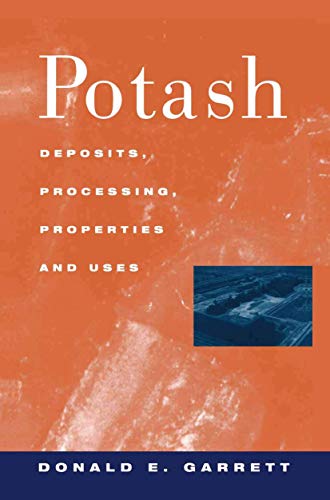Potash: Deposits, Processing, Properties and Uses - Hardcover

"synopsis" may belong to another edition of this title.
"About this title" may belong to another edition of this title.
- PublisherSpringer
- Publication date1995
- ISBN 10 0412990717
- ISBN 13 9780412990717
- BindingHardcover
- Number of pages744
Buy New
Learn more about this copy
Shipping:
US$ 3.99
Within U.S.A.
Top Search Results from the AbeBooks Marketplace
Potash: Deposits, Processing, Properties and Uses
Book Description Condition: New. Seller Inventory # ABLIING23Feb2215580181314
Potash: Deposits, Processing, Properties and Uses by Garrett, D.E. [Hardcover ]
Book Description Hardcover. Condition: new. Seller Inventory # 9780412990717
Potash
Book Description Condition: New. Seller Inventory # 5915373
POTASH: DEPOSITS, PROCESSING, PR
Book Description Condition: New. New. In shrink wrap. Looks like an interesting title! 3.3. Seller Inventory # Q-0412990717
Potash : Deposits; Processing; Properties and Uses
Book Description Condition: New. PRINT ON DEMAND Book; New; Fast Shipping from the UK. No. book. Seller Inventory # ria9780412990717_lsuk
Potash
Book Description Buch. Condition: Neu. This item is printed on demand - it takes 3-4 days longer - Neuware -Potash is the term generally given to potassium chloride, but it is also loosely applied to the various potassium compounds used in agriculture: po tassium sulfate, potassium nitrate or double salts of potassium and magne sium sulfate (generally langbeinite, K S0 - 2MgS0 ). Sometimes the var 2 4 4 ious compounds are differentiated by the terms muriate of potash, sulfate of potash, etc. When referring to ores, or in geology, all of the naturally found potassium salts are called 'potash ores'. However, originally potash referred only to crude potassium carbonate, since its sole source was the leaching of wood ashes in large pots. This 'pot ash' product was generally recovered from near-seacoast plants, such as the saltwort bush, whose ashes were richer in potassium than sodium carbonate. Inland plant's ashes were generally higher in sodium carbonate, giving rise to the word alkali from the Arabic word for soda ash, al kali. The term was then carried over after potassium was discovered to form the latin word for it, kalium. The recovery of potash from ashes became a thriving small cottage industry throughout the world's coastal areas, and developing economies, such as the early set tlers in the United States were able to generate some much-needed income from its recovery and sale. This industry rapidly phased out with the advent of the LeBanc process for producing soda ash in 1792, and the discovery about the same time of the massive sodium-potassium nitrate deposits in the Atacama Desert of Chile. 748 pp. Englisch. Seller Inventory # 9780412990717
Potash : Deposits, Processing, Properties and Uses
Book Description Buch. Condition: Neu. Druck auf Anfrage Neuware - Printed after ordering - Potash is the term generally given to potassium chloride, but it is also loosely applied to the various potassium compounds used in agriculture: po tassium sulfate, potassium nitrate or double salts of potassium and magne sium sulfate (generally langbeinite, K S0 - 2MgS0 ). Sometimes the var 2 4 4 ious compounds are differentiated by the terms muriate of potash, sulfate of potash, etc. When referring to ores, or in geology, all of the naturally found potassium salts are called 'potash ores'. However, originally potash referred only to crude potassium carbonate, since its sole source was the leaching of wood ashes in large pots. This 'pot ash' product was generally recovered from near-seacoast plants, such as the saltwort bush, whose ashes were richer in potassium than sodium carbonate. Inland plant's ashes were generally higher in sodium carbonate, giving rise to the word alkali from the Arabic word for soda ash, al kali. The term was then carried over after potassium was discovered to form the latin word for it, kalium. The recovery of potash from ashes became a thriving small cottage industry throughout the world's coastal areas, and developing economies, such as the early set tlers in the United States were able to generate some much-needed income from its recovery and sale. This industry rapidly phased out with the advent of the LeBanc process for producing soda ash in 1792, and the discovery about the same time of the massive sodium-potassium nitrate deposits in the Atacama Desert of Chile. Seller Inventory # 9780412990717
Potash: Deposits, Processing, Properties and Uses
Book Description Condition: New. Seller Inventory # I-9780412990717

